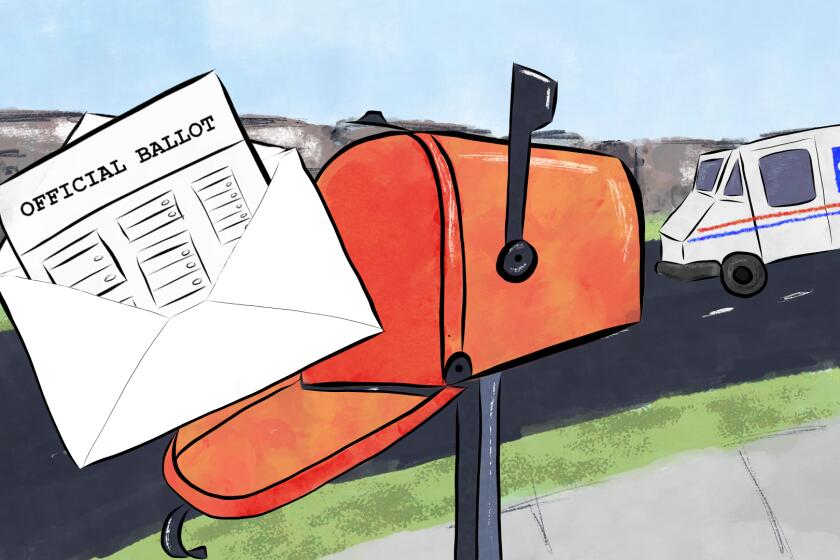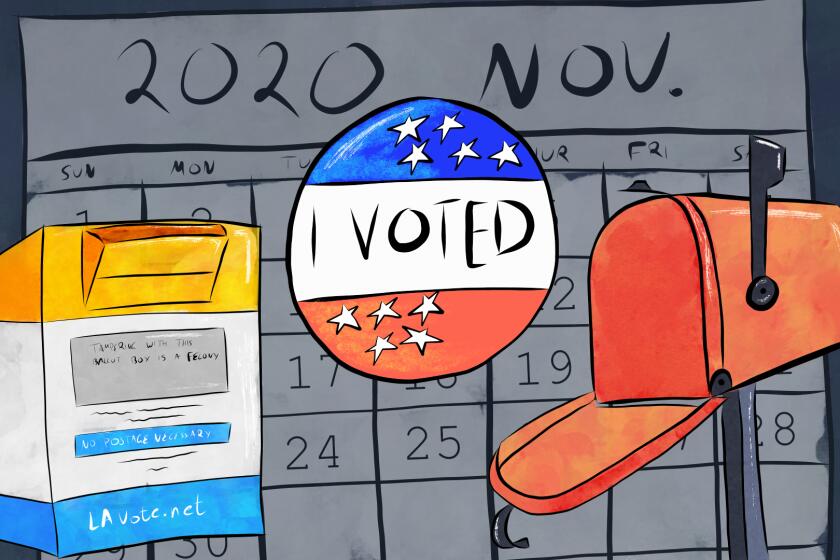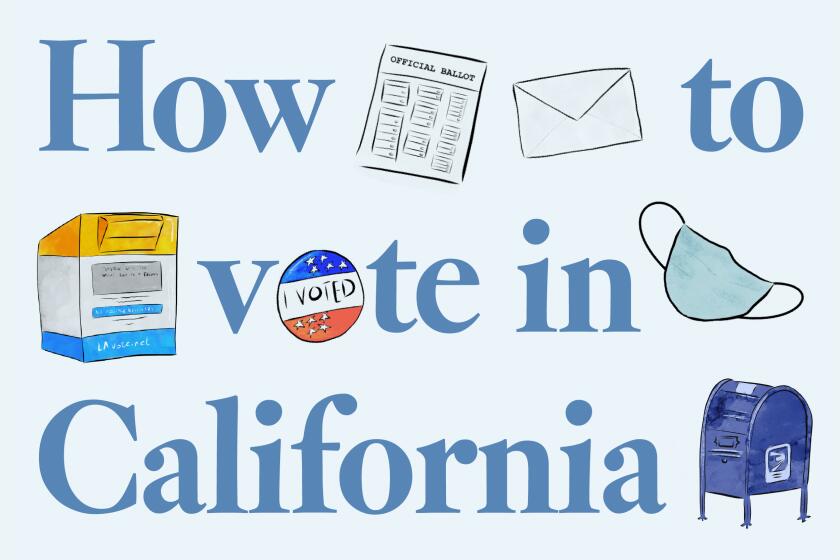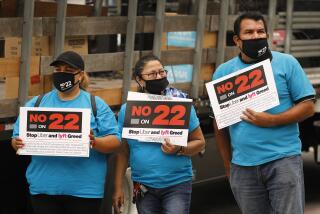What Prop. 22’s defeat would mean for Uber and Lyft — and drivers
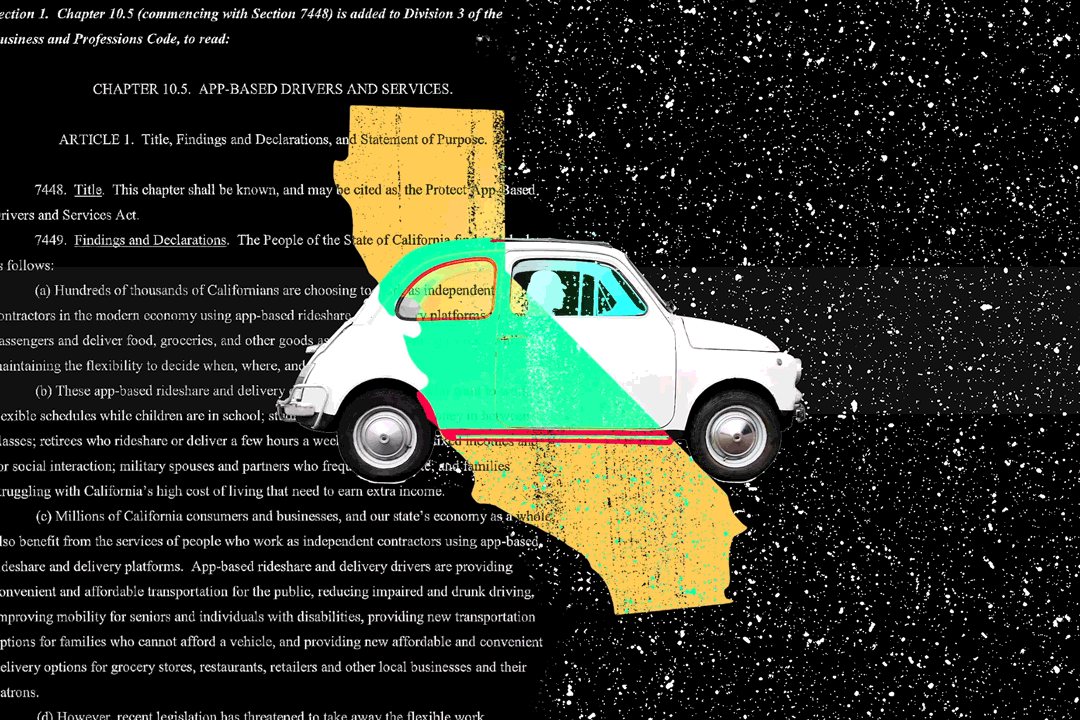
- Share via
One way or another, the business of summoning a ride from your phone is likely to look different in California after Nov. 3.
The future of gig work could hinge on the success or failure of Proposition 22, called the App-Based Drivers as Contractors and Labor Policies Initiative. Uber, Lyft and other companies bankrolling the initiative say it would improve workers’ quality of life, providing new benefits while preserving their autonomy. If passed, the measure would cement gig workers’ status as independent contractors, dealing a huge blow to a labor movement striving to bolster protections for workers at the margins.
Gig companies’ business models rely on hiring large numbers of workers cheaply as independent contractors to provide rides, deliver meals and groceries and perform other services. Assembly Bill 5, a state law passed in 2019, aimed to expand protections to these workers, requiring gig companies to reclassify them as employees.
Proposition 22 represents the companies’ efforts to battle that law and the obligations that come with it.
Uber, Lyft, DoorDash, Instacart and Postmates (which was recently acquired by Uber) have jointly poured close to $200 million into the “yes” campaign, flooding the airwaves and their own apps with ads and making the measure the costliest in U.S. history.
At the heart of it all is a vicious fight to shape the prospects of hundreds of thousands of drivers and delivery workers across the state.
Here’s what you need to know.What would happen if Proposition 22 passes?
For the companies sponsoring it, the short answer is: business as usual. For workers, it would bring some clarity, at a price.
The text of Proposition 22 assures drivers they would maintain flexibility as independent contractors. The measure offers some benefits similar to those conferred under AB 5, but significantly weaker.
Gig companies thus far have resisted compliance with AB 5, which went into effect Jan. 1. In early August, a judge ordered Uber and Lyft to convert their drivers to employees. At the 11th hour, the companies won a temporary stay of the order from a state appeals court, effectively pushing off the deadline until after voters have their say.
Uber and Lyft presented oral arguments before California’s 1st District Court of Appeal on Tuesday. The court has 90 days to decide whether it will uphold the lower-court ruling. But Proposition 22, if passed, would override protections granted by AB 5.
The measure instead would grant 120% of the minimum wage (state or local, depending on where the driver is). However, this minimum narrowly applies to “engaged time,” meaning the time a driver is on a trip with a passenger or en route to pick up a passenger. One study found drivers spend one-third of their time waiting between passengers or returning from trips, time that would not count toward the minimum wage.
Under Proposition 22, workers would also receive reimbursement of 30 cents for each “engaged” mile, but employee status would entitle drivers to 57.5 cents for each mile driven, in accordance with Internal Revenue Service guidance.
The proposition also includes a healthcare subsidy and occupational accident insurance to cover on-the-job injuries.
If gig companies complied with AB 5, workers would have access to the full slate of benefits, including overtime pay for time worked past 40 hours a week, paid sick leave, unemployment insurance and workers’ compensation.
A recent report by UC Berkeley’s Institute for Research on Labor and Employment found employee status would increase total driver compensation by about 30%.
What would the companies sponsoring Proposition 22 do if it fails?
Uber and Lyft have issued a series of contradictory threats about the consequences. Company representatives and the “yes” campaign have said drivers would probably lose flexibility in scheduling as well as the ability to work for multiple platforms. Confusingly, Uber and Lyft have also threatened to leave California altogether if Proposition 22 fails.
Uber Chief Executive Dara Khosrowshahi detailed what he called “the high cost” of making drivers employees in a recent blog post. He said that if Uber employed drivers, the company would be able to hire only 260,000 people full time, out of the nearly 1.2 million drivers in the U.S. before the COVID-19 pandemic.
Specifically in California, Uber projects the number of active drivers the platform could accommodate would fall by 75% if it was forced to treat drivers as employees. Increased labor costs would cause fares to rise 25% to 111%, the company says.
It’s unlikely the companies will follow through on their threat to leave California, one of their biggest markets, said Michael Reich, a labor economist at UC Berkeley who has studied Proposition 22’s effect on drivers extensively and whose work informed ride-hailing regulation adopted in New York. California accounts for about 16% of Lyft’s business and 9% of Uber’s global rides and Uber Eats gross bookings. However, the state represents a negligible fraction of adjusted earnings, Uber has said, according to Reuters.
Instead, the companies will probably continue to challenge AB 5 in the courts, including at the appellate and state Supreme Court levels in California, and then appeal to the U.S. Supreme Court, Reich said. That process would take one to two years.
Although California is the first state to challenge how Uber and Lyft classify drivers (with Massachusetts in a close second place), cities that have instituted minimum wage protections, including New York and Seattle, offer clues as to what a future under AB 5 could look like. In those markets, drivers have been making more hailing rides, Reich said. He predicts even less effect on demand in California from price increases.
“In New York you expect more price sensitivity because you have more transportation — you have the subway, you have more taxis. In California, you don’t have those alternatives,” Reich said.
Crunching the numbers, Reich has a more optimistic view than Uber and Lyft of their ability to transition. He predicts that in California, prices would increase 5% to 10%, while labor costs would go up 25% to 30%. He said Uber’s analysis assumes that every dollar of cost increase translates into a dollar price increase, but that didn’t happen in New York and won’t happen here. He thinks about two-thirds of the cost increase could be offset by greater efficiency in the use of drivers, reduced employee turnover costs and smaller commissions.
Uber’s economist “does not at all explain why the number of drivers would fall so much. She apparently asserts that the company would not hire part-time drivers, even though they would still need them because of the difference between demand during peak and off-peak hours,” Reich said in an email.
In New York, drivers did lose some degree of flexibility, with fewer spots open for new drivers and Uber and Lyft announcing moves to limit access to their apps. The companies locked out drivers at times and in areas of low demand in response to the new regulations, providing a map showing where demand is highest for drivers to find work elsewhere in the city. These changes have been frustrating and even nightmarish for some drivers who say the new system is exhausting to navigate. Labor groups have said the changes by Uber and Lyft were scare tactics meant to undercut new regulations.
One effect of the uncertainty in California’s gig economy that’s already become apparent is the emergence of new players in the state that are willing to comply with AB 5.
Small Texas ride-hailing start-ups Alto and Arcade City have plans to launch in Los Angeles. The two companies employ business models that are completely different from those of the ride-hailing giants.
Arcade City began as a Facebook group connecting thousands of unemployed drivers with residents who needed rides after Uber and Lyft took a yearlong hiatus from Austin when the city tried to impose tighter background checks for drivers. The company offers an interface for drivers who build their own recurring customer base and set their own rates and hours.
Alto hires its drivers as employees and provides them with vehicles. Co-founder and CEO Will Coleman said in an interview that Alto hopes to come to L.A. by the end of November. The start-up has about 200 employees, with plans to hire 100 more.
“We knew this employment model was going to be a question.... We’ve seen the writing on the wall for years,” Coleman said.
If Proposition 22 passes, could it be changed later?
It would be very difficult. Proposition 22’s text carries language that aims to block further legislative action targeted at gig companies.
If passed, amending it would require a seven-eighths supermajority of the Legislature — a daunting hurdle.
In California, a law created by ballot measure can be changed only by another ballot measure, unless the original measure specifies otherwise. Because it’s a hassle to push through ballot measures, initiatives will frequently waive this protection and provide opportunity for the measure to be amended by the Legislature.
A two-thirds majority vote is a common benchmark initiatives use. A seven-eighths majority requirement is unheard of.
“I’ve never seen anything like that. The companies are trying to divest the Legislature of any authority,” said William Gould, a labor lawyer and professor emeritus at Stanford University who studies the gig economy.
Additionally, Proposition 22 would remove the teeth AB 5 gave state lawmakers to challenge companies on worker classification, said Charlotte Garden, a labor law professor at Seattle University School of Law. Before, workers who felt they were being denied benefits typically were shunted into employer-controlled arbitration processes, which had little effect, Garden said. AB 5 empowered California’s attorney general and city attorneys in the state’s most populous cities to force companies to provide benefits to workers who met the legal test for employee classification.
Will Proposition 22 have national implications?
Other states are watching the rollout of AB 5 closely. Experts say Proposition 22 is a test of its success and could establish a precedent across the United States for efforts to restructure the gig economy.
Under President Trump, the federal government has been moving in the opposite direction. In September, the Labor Department issued a proposed rule that is friendlier to employers who use independent contractors.
“Under the Obama administration, the Department of Labor was pushing for a more aggressive ability to find someone as an employee, and it was causing a lot of, I would say, uncertainty in the business community,” said Gina Miller, a law partner in Snell & Wilmer’s Orange County office. “The new administration withdrew that guidance.”
That could change, depending on the outcome of the presidential election. Democratic presidential candidate Joe Biden and his running mate, Sen. Kamala Harris, have voiced support for AB 5 and endorsed a “no” vote on Proposition 22.
Times staff writers Vanessa Martínez, Rahul Mukherjee and Ryan Menezes contributed to this report.
